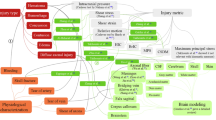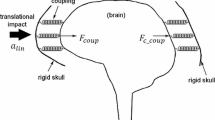Abstract
Animal and anatomic research has shown that head impact direction is an influential parameter in the risk of traumatic brain injury (TBI). In this field, however, not much research has been done on human subjects. The aim of this study is to assess influences of head impact direction on the intracranial responses. Furthermore, brain injury criteria have been developed to predict the influences of impact direction on probability of head injury and brain responses. For this purpose, 150 head impacts were simulated for three magnitudes and 50 directions of translational impact using finite element head model. Simulations were performed to evaluate pressure and stress responses by brain tissues due to changing the impact direction. Next, statistical analysis was used to develop new head injury criteria. The results indicate that TBI risk in simulations with sagittal and frontal planes are higher than those with transverse plane impacts. Furthermore, it has been shown that impact direction is as important as the impact magnitude and duration to develop head injury index. Moreover, new head injury indices have been proposed for predicting von Mises stress, coup pressure, and contrecoup pressure in the brain which have correlation coefficients 0.86, 0.92 and 0.89 with FEM responses, respectively. However, the results of this study show the influence of impact direction on TBI risk. It also indicates that impact direction and brain responses are necessary for developing head injury index.















Similar content being viewed by others
References
Sosin DM, Sniezek JE, Thurman DJ (1996) Incidence of mild and moderate brain injury in the United States, 1991. Brain Inj 10(1):47–54
Covassin T, Swanik CB, Sachs ML (2003) Epidemiological considerations of concussions among intercollegiate athletes. Appl Neuropsychol 10(1):12–22
Faul M, Xu L, Wald MM, Coronado VG (2010) Traumatic brain injury in the United States, Atlanta, GA Natl Cent Inj Prev Control Centers Dis Control Prev, 2010
Rowson S, Brolinson G, Goforth M, Dietter D, Duma S (2009) Linear and angular head acceleration measurements in collegiate football. J Biomech Eng 131(6):61016
Styrke J, Stålnacke B-M, Sojka P, Björnstig U (2007) Traumatic brain injuries in a well-defined population: epidemiological aspects and severity. J Neurotrauma 24(9):1425–1436
Guskiewicz KM et al (2007) Measurement of head impacts in collegiate football players: relationship between head impact biomechanics and acute clinical outcome after concussion. Neurosurgery 61(6):1244–1253
O’Connor C, Colantonio A, Polatajko H (2005) Long term symptoms and limitations of activity of people with traumatic brain injury: a ten-year follow-up. Psychol Rep 97(1):169–179
Deck C, Willinger R (2008) Improved head injury criteria based on head FE model. Int J Crashworthiness 13(6):667–678
Milne G et al (2014) Bicycle helmet modelling and validation under linear and tangential impacts. Int J Crashworthiness 19(4):323–333
Post A, Hoshizaki TB, Gilchrist M, Brien S (2012) Analysis of the influence of independent variables used for reconstruction of a traumatic brain injury incident. Proc Inst Mech Eng Part P J Sport Eng Technol 226(3–4):290–298
Gennarelli TA, Thibault LE, Ommaya AK (1972) Pathophysiologic responses to rotational and translational accelerations of the head, SAE Technical Paper, RPRT, 1972
Post A, Hoshizaki TB, Gilchrist MD, Brien S, Cusimano MD, Marshall S (2014) The influence of acceleration loading curve characteristics on traumatic brain injury. J Biomech 47(5):1074–1081
Gennarelli TA, Thibault LE, Adams JH, Graham DI, Thompson CJ, Marcincin RP (1982) Diffuse axonal injury and traumatic coma in the primate. Ann Neurol 12(6):564–574
Gennarelli TA, Thibault LE, Tomei G, Wiser R, Graham D, Adams J (1987) Directional dependence of axonal brain injury due to centroidal and non-centroidal acceleration, SAE Tech. Pap., No. 872197
Kleiven S (2003) Influence of impact direction on the human head in prediction of subdural hematoma. J Neurotrauma 20(4):365–379
Huang H-M, Lee M-C, Chiu W-T, Chen C-T, Lee S-Y (1999) Three-dimensional finite element analysis of subdural hematoma. J Trauma Acute Care Surg 47(3):538–544
Ommaya AK (1985) Biomechanics of head injury: experimental aspects. Biomech Trauma 13:245–269
Kimpara H, Iwamoto M (2012) Mild traumatic brain injury predictors based on angular accelerations during impacts. Ann Biomed Eng 40(1):114–126
Takhounts EG, Craig MJ, Moorhouse K, McFadden J, Hasija V (2013) Development of brain injury criteria (Br IC). Stapp Car Crash J 57:243
Post A, Hoshizaki TB, Gilchrist MD, Brien S, Cusimano M, Marshall S (2015) Traumatic brain injuries: the influence of the direction of impact. Neurosurgery 76(1):81–91
Hernandez F et al (2015) Six degree-of-freedom measurements of human mild traumatic brain injury. Ann Biomed Eng 43(8):1918–1934
Gabler L, Crandall J, Panzer M (2016) Investigating brain injury tolerance in the sagittal plane using a finite element model of the human head. Int J Automot 7(1):37–43
Bandak FA, Zhang AX, Tannous RE, DiMasi F, Masiello P, Eppinger RH (2001) Simon: a simulated injury monitor; application to head injury assessment. In: Proceedings: International Technical Conference on the enhanced safety of vehicles, vol. 2001, p 7–p
Broglio SP et al (2010) The biomechanical properties of concussions in high school football. Med Sci Sports Exerc 42(11):2064
Broglio SP, Sosnoff JJ, Shin S, He X, Alcaraz C, Zimmerman J (2009) Head impacts during high school football: a biomechanical assessment. J Athl Train 44(4):342–349
Duma SM, Rowson S (2011) Past, present, and future of head injury research. Exerc Sport Sci Rev 39(1):2–3
Greenwald RM, Gwin JT, Chu JJ, Crisco JJ (2008) Head impact severity measures for evaluating mild traumatic brain injury risk exposure. Neurosurgery 62(4):789
Rowson S, Beckwith JG, Chu JJ, Leonard DS, Greenwald RM, Duma SM (2011) A six degree of freedom head acceleration measurement device for use in football. J Appl Biomech 27(1):8–14
Kleiven S (2006) Evaluation of head injury criteria using a finite element model validated against experiments on localized brain motion, intracerebral acceleration, and intracranial pressure. Int J Crashworthiness 11(1):65–79
Svein K (2007) Predictors for traumatic brain injuries evaluated through accident reconstructions. Stapp Car Crash J. 51:81–114
Takhounts EG, Eppinger RH, Campbell JQ, Tannous RE (2003) On the development of the SIMon finite element head model. Stapp Car Crash J. 47:107
Takhounts EG, Hasija V, Ridella SA, Rowson S, Duma SM (2011) Kinematic rotational brain injury criterion (BRIC). In: Proceedings of the 22nd enhanced safety of vehicles Conference. Paper No. 11–0263
Versace J (1971) A review of the severity index. SAE Technical Paper
Gadd CW (1966) Use of a weighted-impulse criterion for estimating injury hazard (No. 660793). SAE Technical Paper
Rowson S et al (2012) Rotational head kinematics in football impacts: an injury risk function for concussion. Ann Biomed Eng 40(1):1–13
Rowson S, Duma SM (2011) Development of the STAR evaluation system for football helmets: integrating player head impact exposure and risk of concussion. Ann Biomed Eng 39(8):2130–2140
Wilde EA et al (2006) Diffusion tensor imaging in the corpus callosum in children after moderate to severe traumatic brain injury. J Neurotrauma 23(10):1412–1426
Dikmen SS, Corrigan JD, Levin HS, Machamer J, Stiers W, Weisskopf MG (2009) Cognitive outcome following traumatic brain injury. J Head Trauma Rehabil 24(6):430–438
Bhatoe HS (1999) Primary brainstem injury: benign course and improved survival. Acta Neurochir (Wien) 141(5):515–519
Atabaki SM (2007) Pediatric head injury. Pediatr Rev 28(6):215
Amen DG, Wu JC, Taylor D, Willeumier K (2011) Reversing brain damage in former NFL players: implications for traumatic brain injury and substance abuse rehabilitation. J Psychoactive Drugs 43(1):1–5
Horgan TJ, Gilchrist MD (2003) The creation of three-dimensional finite element models for simulating head impact biomechanics. Int J Crashworthiness 8(4):353–366
Ghaffari M, Rostami M, Zoghi M, Abolfathi N (2012) A new approach to model subarachoid trabeculae resistance in cerebrospinal fluid flow. In: 2012 19th Iranian Conference of Biomedical Engineering (ICBME) pp 7–11
Ghaffari M, Zoghi M, Rostami M, Abolfathi N (2014) Fluid structure interaction of traumatic brain injury: effects of material properties on sas trabeculae. Int J Mod Eng 14(2):54–62
Saboori P, Sadegh A (2011) Brain subarachnoid space architecture: histological approach. In: ASME 2011 International mechanical engineering congress and exposition, IMECE 2011, vol 2, pp 89–94
Zhou C, Khalil TB, King AI (1997) Viscoelastic response of the human brain to sagittal and lateral rotational acceleration by finite element analysis. In: International IRCOBI Conference on the Biomechanics of Impacts, Dublin
Nahum AM, Smith R, Ward CC (1977) Intracranial pressure dynamics during head impact
Trosseille X, Tarriére C, Lavaste F, Guillon F, Domont A (1992) Development of a FEM of the human head according to a specific test protocol
Doorly MC (2007) Investigations into head injury criteria using numerical reconstruction of real life accident cases. University College Dublin
Shuck LZ, Advani SH (1972) Rheological response of human brain tissue in shear. J Basic Eng 94(4):905–911
Acknowledgements
This research received no specific grant from any funding agency in the public, commercial, or not-for-profit sectors.
Author information
Authors and Affiliations
Corresponding author
Ethics declarations
Conflict of interest
The authors declare that they have no conflicts of interest.
Additional information
Technical Editor: Estevam Barbosa Las Casas.
Rights and permissions
About this article
Cite this article
Afshari, J., Haghpanahi, M. & Kalantarinejad, R. Developing new brain injury criteria for predicting the intracranial response by calculating von Mises stress, coup pressure and contrecoup pressure. J Braz. Soc. Mech. Sci. Eng. 39, 3729–3741 (2017). https://doi.org/10.1007/s40430-017-0830-9
Received:
Accepted:
Published:
Issue Date:
DOI: https://doi.org/10.1007/s40430-017-0830-9




